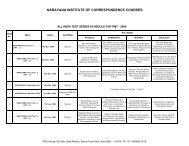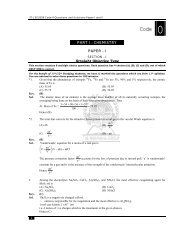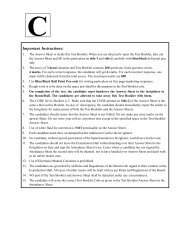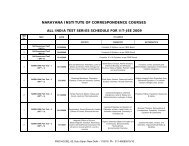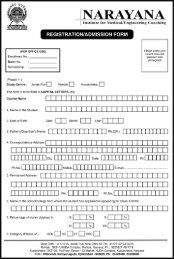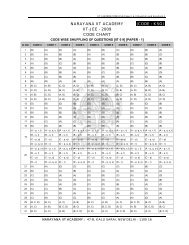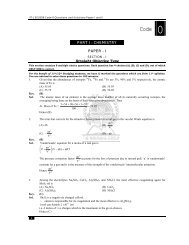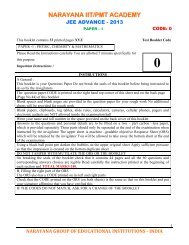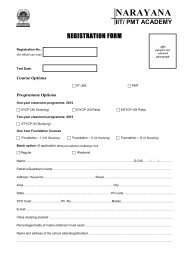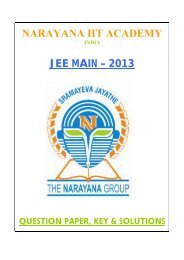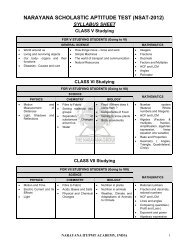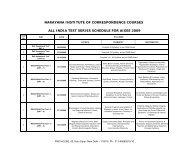NARAYANA IIT/PMT ACADEMY - Narayanaicc.com
NARAYANA IIT/PMT ACADEMY - Narayanaicc.com
NARAYANA IIT/PMT ACADEMY - Narayanaicc.com
Create successful ePaper yourself
Turn your PDF publications into a flip-book with our unique Google optimized e-Paper software.
<strong>NARAYANA</strong> <strong>IIT</strong>/<strong>PMT</strong> <strong>ACADEMY</strong><br />
JEE ADVANCE : 2013<br />
(PAPER – II) CODE: 0<br />
36 R, S and T, respectively, are<br />
(A) SO 2 Cl 2 , PCl 5 and H 3 PO 4 (B) SO 2 Cl 2 , PCl 3 and H 3 PO 3<br />
(C) SOCl 2 , PCl 3 and H 3 PO 2 (D) SOCl 2 , PCl 5 and H 3 PO 4<br />
Ans<br />
(A)<br />
SECTION – 3 (Matching List Type)<br />
This section contains 4 multiple choice questions Each question has matching lists The codes for the<br />
lists have choices (A), (B), (C) and (D) out of which ONLY ONE is correct<br />
37 An aqueous solution of X is added slowly to an aqueous solution of Y as shown in List I The<br />
variation in conductivity of these reaction is given in List II Match List I with List II and select<br />
the correct answer using the code given below the lists:<br />
List I<br />
P (C 2 H 5 ) 3 N + CH 3 COOH<br />
X<br />
Y<br />
Q KI(01M) + AgNO 3 (001M)<br />
X<br />
Y<br />
R CH 3 COOH + KOH<br />
X Y<br />
S NaOH + HI<br />
X Y<br />
Code :<br />
P Q R S<br />
(A) 3 4 2 1<br />
(B) 4 3 2 1<br />
(C) 2 3 4 1<br />
(D) 1 4 3 2<br />
List II<br />
1 Conductivity decreases and then increases<br />
2 Conductivity decreases and then doest not<br />
change much<br />
3 Conductivity increases and then does not<br />
change much<br />
4 Conductivity does not change much and then<br />
increases<br />
Ans<br />
(A) Factual<br />
38 The standard reduction potential data at 25 0 C is given below<br />
E 0 (Fe 3+ , Fe 2+ ) = +077 V<br />
E 0 (Fe 2+ , Fe) = 044 V<br />
E 0 (Cu 2+ , Cu) = +034 V;<br />
E 0 (Cu 2+ , Cu) = +052 V<br />
E 0 [O 2 (g) + 4H + + 4e 2H 2 O] = +123 V<br />
E 0 [O 2 (g) + 2H 2 O + 4e 4OH ] = +040V<br />
E 0 (Cr 3+ , Cr) = 074 V;<br />
E 0 (Cr 2+ , Cr) = 091 V;<br />
Match E 0 of the redox pair in List I with the values given in List II and select the correct answer<br />
<strong>NARAYANA</strong> GROUP OF EDUCATIONAL INSTITUTIONS - INDIA<br />
21



